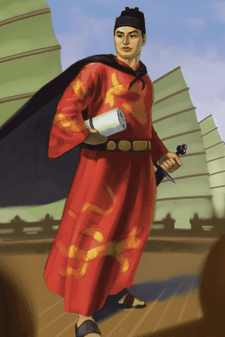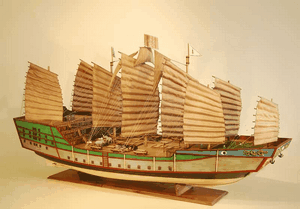Years before Columbus sailed the ocean blue, another country began an ambitious exploration of the world with a fleet of ships. It is an often overlooked part of history because this huge ocean expedition was not launched by a European country. It was launched by China, and it is still considered by many historians as one of the most impressive navel efforts ever undertaken. More, it is possible that this Chinese fleet may have visited the ‘undiscovered’ Americas before Columbus.
During the Ming dynasty, which established itself in China in 1368 by ousting the hated Mongol conquerors; China experienced one of its greatest eras of power and prosperity.  The early Ming emperors manifested that great power by sending military expeditions to demand tribute from distant princelings and potentates. The most dramatic example of such Ming diplomatic activity was a series of seven voyages under the command of Grand Eunuch Zheng He. During those expeditions, the Ming fleet sailed from Nanjing for the Indian Ocean and reached as far as Mecca in Arabia and Mogadishu and Malindi in East Africa.
The early Ming emperors manifested that great power by sending military expeditions to demand tribute from distant princelings and potentates. The most dramatic example of such Ming diplomatic activity was a series of seven voyages under the command of Grand Eunuch Zheng He. During those expeditions, the Ming fleet sailed from Nanjing for the Indian Ocean and reached as far as Mecca in Arabia and Mogadishu and Malindi in East Africa.
Zheng He was born in 1371 AD as Ma Sanbao in Yunnan Province. His family was possibly Turkish or Mongol and may have formed part of the local Mongol garrison. They were Muslims, as is indicated by their surname Ma, which is Chinese for Muhammad. Both Zheng He’s father and grandfather also claimed the title of hajji, which shows that they had made the pilgrimage to Mecca. In 1382, Zheng He was recruited for service in the emperor’s palace and became a eunuch at the age of 10. The operation apparently did not stunt Zheng He’s growth; family tradition credited him with being seven feet tall and having a waist of five feet around. He was assigned to the service of Prince Zhu Di, who would later become the Yongle emperor, where he performed great deeds as a warrior during the campaigns against the Mongols and during Zhu Di’s successful revolt against his nephew, the emperor Jianwen, in 1402. After taking on the new name of Yongle, the new emperor renamed his faithful eunuch Zheng and gave him the title of grand eunuch.
Zheng He’s expeditions were fitted out at Nanjing and consisted of hundreds of ships and thousands of crew and soldiers, though not all were used on each expedition. The largest of the vessels were the so-called treasure ships, which were reported to be about 450 feet long, far larger than any European ship. After leaving Nanjing, the fleet would sail to the mouth of the Min Jiang River in Fujien Province to await the favorable monsoon winds in January and February that would carry the fleet to its destination.
On July 11, 1405, Zheng He embarked on the first of seven great maritime expeditions. The destination was the Indian Ocean, or Western Ocean, as the Chinese called it. During the expedition, the armada visited Champa (modern South Vietnam), Java, Ceylon (modern Sri Lanka), and finally Calicut on the Indian subcontinent. Calicut, an important depot in the pepper trade, was the principal destination of the voyage. Along the way, the Chinese picked up exotic products and treasures and arranged for foreign embassies to visit the Ming capital at Nanjing.
The reason for the expedition is not clear. Some sources claim that its purpose was to search for the deposed emperor Jianwen, who may have escaped the burning of his palace by rebel forces. The search must not have been too important, however, because little time was spent looking for the fugitive during the expedition.
A more plausible and substantial reason for it (and for the expeditions that followed) was the emperor’s desire to demonstrate his power unquestionably to various foreign states and so enhance his prestige, both at home and abroad. The Yongle emperor had an unconventionally strong interest in foreign affairs and expansion, which was probably encouraged by Zheng He and his associates.The Yongle emperor was apparently so pleased with the results of the first expedition that he ordered a second one almost immediately. Zheng He did not accompany that expedition, the mission of which was simply to attend the installation of Mana Vikrama as the new king of Calicut, but when a third expedition was ordered, Zheng He assumed personal command. The third flotilla visited Champa, Java, Malacca, Ceylon, Cochin, and Calicut, but its outstanding accomplishment was the defeat and capture of the Sinhalese king on Ceylon. Zheng He carried the king back to Nanjing, where the Yongle emperor ordered his release—but not before a new king was put into place. Once again, the strength of the Chinese military clearly manifested itself, this time to the states of the Indian subcontinent.
Despite the success of these voyages, pressure was building in the emperor’s court to discontinue them. Most Confucian bureaucrats within the court hated the idea of oversea’s adventurism and the opening of China to foreign eyes. But the star power of Zheng He was not yet descending and Zheng He began pushing for an expanded navy and additional oversea’s exploration. But would his influence on the emperor (which no doubt the bureaucrats also feared) be enough to continue China’s expansion on the open seas.
Find out in the next article The Forgotten Voyages Of Zheng He …


